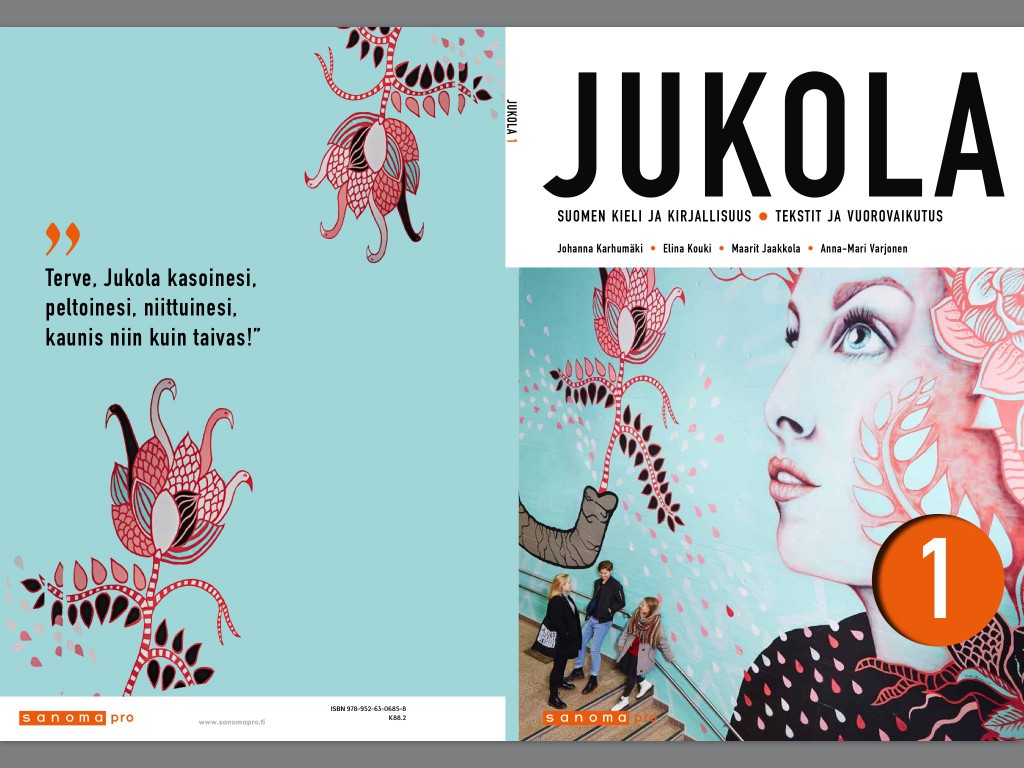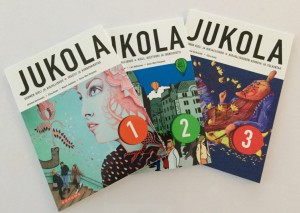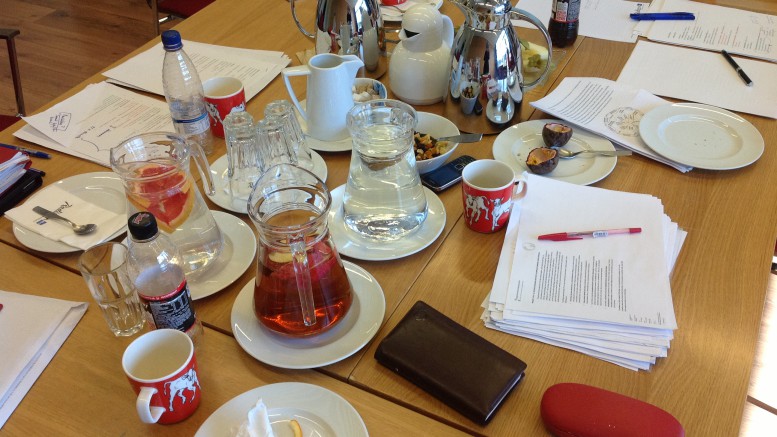Below is the cover image of the brand new upper-secondary-school textbook Jukola that will come out at SanomaPro later this month. This course book will start a new series in the discipline of the Finnish language and literature at upper secondary schools.

The book is a result of a couple of years’ hard work. The next textbooks will be published in the years coming, and they conform to the new national curriculum that will be implemented at Finnish schools next Fall. I am very thankful for having been able to contribute to this project as a co-author responsible for issues concerning media and journalism.
What I learned is that writing an upper-secondary-school textbook is a very special genre. A school book author is bound to many pre-requirements from many directions. Textbooks are on-demand functional literature that has to be usable in a variety of contexts. There are thus quite a few things that can go wrong and you have to find a balance between:
- The target group: It goes without saying that a textbook is written for students. Or does it? It is the teachers who in reality decide whether to adopt the book in pedagogical use or not. It may sometimes be difficult to please both at the same time.
- The curriculum basis: The contents should conform to the national curriculum. But when we started writing the book(s) a couple of years ago, no one was sure about what the national curriculum 2016 would entail.
- Ideological neutrality: Parents and societal debaters are the stakeholders of schooling, and they are often particularly sensitive to ideological biases that they eagerly attempt to find in the junior citizens’ learning material. An ideal school book should probably thus be ideologically neutral – which is, as we know from the theory of social constructionism, an ideal that can never be fully reached…
- Geographical balance: A nationally used book should avoid Helsinki-centeredness, which means in practice, for example, that media texts should not be picked from just Helsingin Sanomat but geographically represent voices from other areas as well. However, as many roads lead to Rome, so do many debate openings and issues with national relevance boil down to the biggest daily newspaper.
- Gender balance: The material used, in particular images and texts, should not be gender-biased. A simple body-count of males and females is apparently not enough as there is also the third gender and the issue of gendered practices is far more complicated. Once you happen to find a fantastic sample of text you might discover that it is not exactly gender-sensitive, or it represents gendered structures of power that you would rather not want to enforce.
- Genre balance: Text samples related to exercises should not represent one or two genres only, but be versatile, ranging from lyrics to prose, from journalistic texts to advertising. Even within a single category, such “journalistic texts”, the samples should represent a variety of genres, such as news, column, reportage, interview, letters-to-the-editor. And once you happen to find a fantastic sample of text you might discover that it represents the same genre as the previous six text samples.
- Canonical conformity: A textbook unavoidably reflects a canon constructed by society in the long run, but, at least in my opinion, the book should also provide students with materials to question the canon-formation. Many subversive texts printed in an official school book, however, may be falsely received as “propaganda” or attempts of “brainwashing” from the side of the authors.
- Didactical variance: The exercises should not represent one learning style only. Any textbook format chosen, however, pose their restrictions regarding the use of different methods and media.
- Transformativity of research knowledge: A school book has to be based on the findings of the latest research. As shown by one of the authors of the book series in her dissertation, scientific concepts are not always easily transformable to the context of learning.
- Time resistance: A print book that comes out in 2016 should be usable in many years to come without appearing within a couple of years as old-fashioned or ridiculously obsolete. However, while you want to establish relationships to the surrounding reality and not just speak of things in theory, it may be difficult to identify questions, events and people that will still be recognisable and thus illustrative in two, five, or even ten years of time.
- Multimediality: In 2016, a lot of learning material in particular from the bigger publishers is still produced according to the 20th-century production model in which a print book is placed to the centre and complemented with e-learning materials fully designed and controlled by the publisher. As schools vary a great deal regarding their resources of using online tools and platforms, it is relatively difficult to involve any more flexible ways of online learning, let alone produce multimedia or transmedia contents.
 I do not regard the multitude of requirements as a bad thing; they just build up a frame for the production that distinguishes the authoring of a curriculum-bound school book from a stand-alone non-fiction book. It is important that they do not kill the authors’ creativity and phantasy. Luckily, school books are typically realised in big teams where different ideas, ideologies, preferences, materials and methods can fruitfully be compared, questioned and cross-fertilised. Different author profiles ideally challenge and complement each other.
I do not regard the multitude of requirements as a bad thing; they just build up a frame for the production that distinguishes the authoring of a curriculum-bound school book from a stand-alone non-fiction book. It is important that they do not kill the authors’ creativity and phantasy. Luckily, school books are typically realised in big teams where different ideas, ideologies, preferences, materials and methods can fruitfully be compared, questioned and cross-fertilised. Different author profiles ideally challenge and complement each other.
The cover image for the first course book is taken from a new railway station along the Ring Rail Line between Helsinki airport and city centre opened last year. It may refer to a slight Metropolitan bias and evoke arguments related to the points listed above. Unless we interpret it in a way that a road can always be travelled two ways: from the capital towards the inlands, and the other way round – the circle can, and should be broken?
Anyway, it feels great to finally see the result of the work between covers. At least I am eager to hear the first comments of teachers and students and ready to confront the criticism.

Be the first to comment on "Challenges in writing a high school textbook"